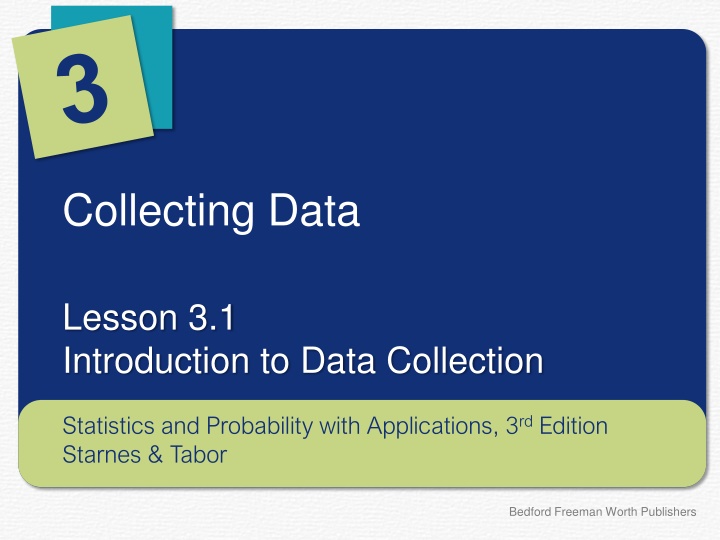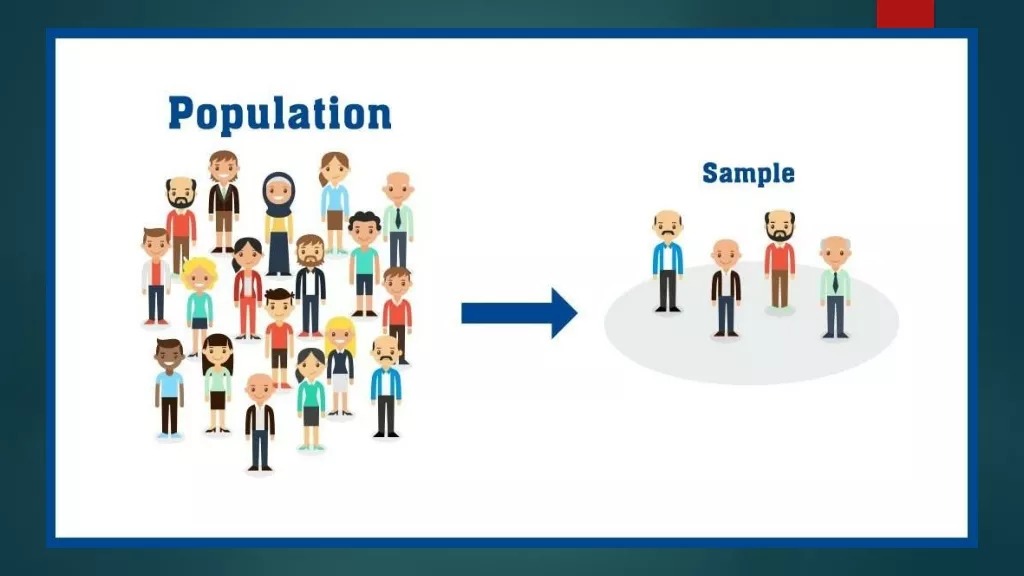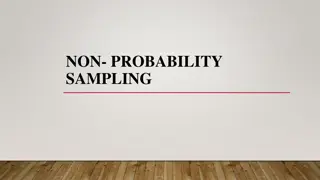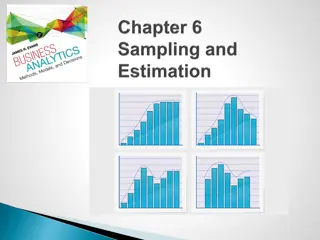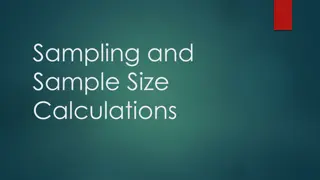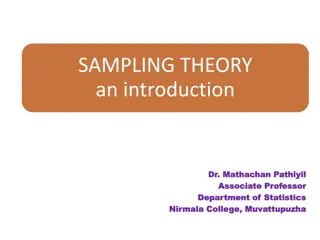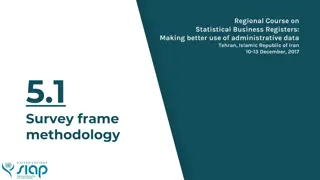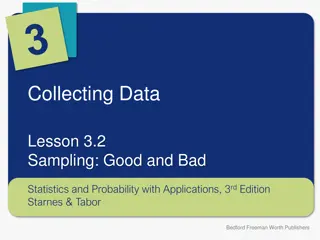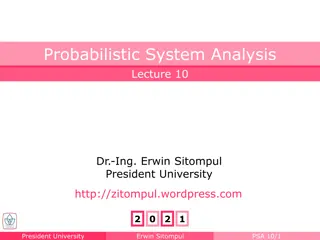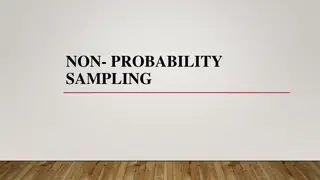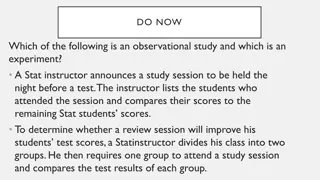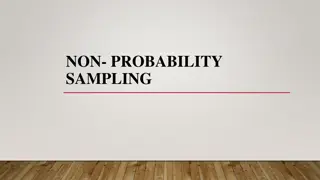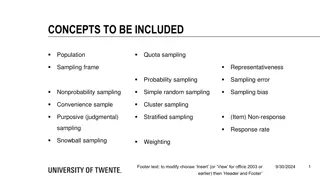Introduction to Data Collection & Statistics: Understanding Statistical Questions, Population, and Sampling
This material introduces the fundamental concepts of data collection and statistics. Learning objectives include distinguishing statistical questions, identifying populations and samples, and understanding the difference between observational studies and experiments. It discusses the process of statistical problem-solving, from asking valid questions to interpreting results, with practical examples and explanations. Key topics covered include defining statistical questions, population versus sample, and the importance of data variation in statistical inquiries.
Download Presentation

Please find below an Image/Link to download the presentation.
The content on the website is provided AS IS for your information and personal use only. It may not be sold, licensed, or shared on other websites without obtaining consent from the author.If you encounter any issues during the download, it is possible that the publisher has removed the file from their server.
You are allowed to download the files provided on this website for personal or commercial use, subject to the condition that they are used lawfully. All files are the property of their respective owners.
The content on the website is provided AS IS for your information and personal use only. It may not be sold, licensed, or shared on other websites without obtaining consent from the author.
E N D
Presentation Transcript
Collecting Data Lesson 3.1 Introduction to Data Collection Statistics and Probability with Applications, 3rdEdition Starnes & Tabor Bedford Freeman Worth Publishers
Introduction to Data Collection Learning Targets After this lesson, you should be able to: Distinguish statistical questions from other types of questions. Identify the population and sample in a statistical study. Distinguish between an observational study and an experiment. Statistics and Probability with Applications, 3rdEdition 2 2
Introduction to Data Collection A statistics problem starts with a statistical question. Not just any question will do. A valid statistical question is based on data that vary. That is, the answer to the question won t be the same each time an observation is recorded. How to Complete the Statistical Problem-Solving Process Ask questions: Clarify the research problem and ask one or more valid statistical questions. Collect data: Design and carry out an appropriate plan to collect the data. Analyze data: Use appropriate graphical and numerical methods to analyze the data. Interpret results: Draw conclusions based on the data analysis. Statistics and Probability with Applications, 3rdEdition 3 3
Video games, vanilla, and violence? Video games, vanilla, and violence? Asking valid statistical questions Asking valid statistical questions PROBLEM: Determine if each of the following is a valid statistical question. Justify your answer. (a) How many days did students at your school play video games last week? Valid. The answer to this question is based on data that vary the number of days that each student at your school played video games. (b) Which gender is more likely to choose vanilla over chocolate ice cream? Valid. The answer to this question is based on data that vary whether each person would choose vanilla over chocolate ice cream. (c) How many people in the United States were convicted of violent crimes last year? Not valid. This question can be answered with a single value that doesn t vary. Statistics and Probability with Applications, 3rd Edition 4 4
Introduction to Data Collection Suppose we want to find out what percent of young drivers in the United States text while driving. To answer the question, we will survey 16- to 20-year-olds who live in the United States and drive. Ideally, we would ask them all (take a census). But contacting every driver in this age group wouldn t be practical. It would take too much time and cost too much money. Instead, we put the question to a sample chosen to represent the entire population of young drivers. Population, Census, and Sample The population in a statistical study is the entire group of individuals we want information about. A census collects data from every individual in the population. A sample is a subset of individuals in the population from which we collect data. Statistics and Probability with Applications, 3rd Edition 5 5
Introduction to Data Collection Population Collect data from a representative Sample... Sample Statistics and Probability with Applications, 3rd Edition 6 6
Bears and Beyonc songs: Which is which? Bears and Beyonc songs: Which is which? Populations and samples Populations and samples PROBLEM: Identify the population and sample in each of the following settings. (a) A wildlife biologist in Alaska tranquilizes 42 grizzly bears in the state, records their weights, and then releases them. Population: All grizzly bears in Alaska. Sample: The 42 grizzly bears that were weighed. (b) A teenager selects 15 Beyonc songs and counts the number of words in each song. Population: All songs recorded by Beyonc . Sample: The 15 Beyonc songs that had words counted. Statistics and Probability with Applications, 3rd Edition 7 7
Introduction to Data Collection A sample survey usually aims to gather information about a population without disturbing the population in the process. Sample surveys are one kind of observational study. In contrast to observational studies, experimentsdon t just observe individuals or ask them questions. They actively impose some treatment to measure the response. Observational Study, Experiment An observational study observes individuals and measures variables of interest, but does not attempt to influence the responses. An experiment deliberately imposes some treatment on individuals to measure their responses. Statistics and Probability with Applications, 3rd Edition 8 8
Introduction to Data Collection The distinction between observational study and experiment is one of the most important ideas in statistics. The goal of an observational study can be to describe some group or situation, to compare groups, or to examine relationships between variables. The purpose of an experiment is to determine if the treatment causes a change in the response. An observational study, even one based on a random sample, is a poor way to gauge the effect that changes in one variable have on another variable. When the goal is to understand cause and effect, experiments are the only source of fully convincing data. Statistics and Probability with Applications, 3rd Edition 9 9
Do fast Do fast- -paced cartoons affect our behavior? paced cartoons affect our behavior? Observational studies and experiments Observational studies and experiments PROBLEM: Determine whether each of the following settings describes an observational study or an experiment. Explain your reasoning. (a) Sixty 4-year-old children were randomly divided into three groups. One group was shown a fast-paced cartoon, one group was shown an educational cartoon, and one group was given art supplies and instructed to draw pictures. Afterward, the 4-year-olds who watched the fast-paced cartoon scored significantly worse than the other two groups on tests that measured the ability to make decisions. http://pediatrics.aappublications.org/content/early/2011/09/08/peds.201 0-1919.abstract Experiment. Treatments were imposed on the 4-year-old children. Some children were assigned to watch a fast-pace cartoon, some were assigned to watch a slow-paced cartoon, and some were assigned to draw pictures. Statistics and Probability with Applications, 3rd Edition 10 10
Do fast Do fast- -paced cartoons affect our behavior? paced cartoons affect our behavior? Observational studies and experiments Observational studies and experiments PROBLEM: Determine whether each of the following settings describes an observational study or an experiment. Explain your reasoning. (b) One hundred teenagers between the ages of 16-18 were surveyed. The teens were asked whether, as young children, they watched fast- paced cartoons more often than, less often than, or about equally as often as educational cartoons. They were also asked to reveal their GPA. The teens who watched fast-paced cartoons more often than educational cartoons had lower GPAs than teens from the other two groups, on average. Observational study. There were no treatments imposed on the teens. The teens were not told which cartoons to watch or how often to watch them. Statistics and Probability with Applications, 3rd Edition 11 11
LESSON APP 3.1 Do you have dinner plans? Researchers at Columbia University randomly selected 1000 teen- agers in the United States for a survey. According to an ABC News article about the research, Teenagers who eat with their families at least five times a week are more likely to get better grades in school. 1. What is the statistical question that the researchers were trying to answer? 2. Identify the population and sample. 3. Is this an observational study or an experiment? Explain. Statistics and Probability with Applications, 3rd Edition 12 12
LESSON APP 3.1 Do you have dinner plans? 1. What is the statistical question that the researchers were trying to answer? 2. Identify the population and sample. 3. Is this an observational study or an experiment? Explain. Statistics and Probability with Applications, 3rd Edition 13 13
Introduction to Data Collection Learning Targets After this lesson, you should be able to: Distinguish statistical questions from other types of questions. Identify the population and sample in a statistical study. Distinguish between an observational study and an experiment. Statistics and Probability with Applications, 3rd Edition 14 14
